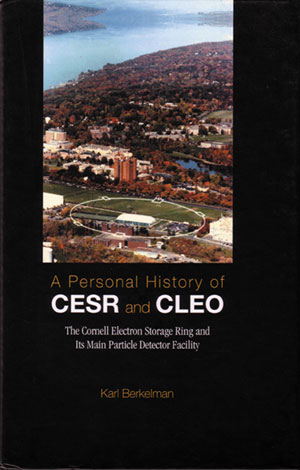by Karl Berkelman, World Scientific. Hardback ISBN 9812386971, $52 (£38).

This slim volume relates in chronological order the main events in the story of the particle-physics laboratory at Cornell, from its foundation in the days when any major university would have the ambition and generally the means to found and run its own particle accelerator, to the present day, in which Cornell has the only front-rank accelerator not based in a national or international laboratory. The story of how Cornell survived and prospered as similar laboratories foundered is a fascinating one.
The Laboratory of Nuclear Studies was founded as faculty members of Cornell University, New York, returned from duties on the Manhattan Project in 1946. Shortly thereafter, the first director, Robert Bacher, left for the Atomic Energy Commission and Bob Wilson was hired from Harvard to replace him. The Cornell ethos that underpins the remarkable success of the laboratory emanates in large part from Wilson’s “can do” mentality and determination to cut out all frills and many corners in order to get the biggest “bang for the buck” spent on an accelerator. The faculty pitched in enthusiastically and became experts in a wide variety of techniques in both accelerator physics and analysis. After Wilson left to found Fermilab, “Mac” McDaniel continued his tradition of inspiring leadership, although with a very different style.
Berkelman himself took over in 1985, bringing his own style of modest, calm but inspirational leadership to the still-juvenile CESR machine and detectors. The book is the story not only of some remarkable accelerators, but also of a remarkable experiment, CLEO, as well as its sister experiment for many years, CUSB. Perpetually renewing itself as it passed from CLEO-I through various integers and half-integers to CLEO-III, the collaboration grew but always retained the very democratic outlook that Berkelman considers the secret of its success. This success is impressive indeed; in 2001, over half the entries in the PDG tables for B mesons and charmed mesons and baryons were established by results from CESR.
The success of a lab depends greatly on the personality of charismatic leaders, and in many ways this book is the story of three of them: Wilson, McDaniel and Maury Tigner. Tigner rides to the rescue at several moments of crisis in his predecessors’ reigns with a typically inspired technical solution or idea, and it is in his capable hands that the future of the laboratory now lies. Naturally, the book downplays the influence of Berkelman himself, which was large, but it makes clear the other important factor in Cornell’s success – the strength in depth in the faculty and the dedication of all the staff. Perhaps another visible thread throughout the narrative is the long-standing rivalry between SLAC and Cornell, always simmering below the surface and occasionally erupting in open contests such as the competition with the PEP machine and the discussions on the site for a US B-factory. Berkelman is illuminating on some of the factors he believes played a part in these decisions and the role of the National Science Foundation in steadfastly supporting the laboratory while perforce leaving it substantially free to run its own affairs.
Berkelman has a straightforward and clear style, and there are several interesting and enlightening illustrations. However, despite the claim in the preface that he tried “to broaden its accessibility to a wider audience” than particle physicists, it is difficult to believe that any such readers will be able to make much progress through the host of technicalities in both machine physics and particle physics that are inevitable in a book of this kind, and which indeed give it much of its value. On the other hand, physicists who either know and/or love the Cornell that is the real hero of this book, or who wish to discover the reasons behind its remarkable and in many ways unique success, will find much food for thought in this interesting and valuable exposition.








